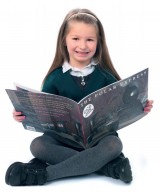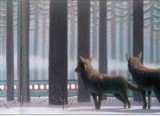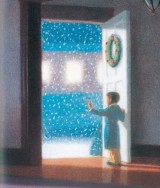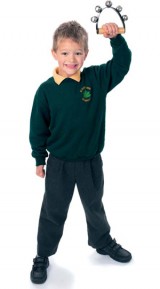Purchase a ticket for The Polar Express, says Gill Matthews, and take your class on a magical literary journey to the North Pole...
The Polar Express (Anderson Press), written and illustrated by Chris Van Allsburg, is a magical picture book that can be enjoyed by children of all ages, and which offers many opportunities for introducing and developing visual literacy skills. Its distinctive illustrations are almost photographic in style, inviting readers to pore over them, spotting details and elements that add to the story. In the classroom, using a visualiser will allow every child to see the illustrations in detail as you work through the book.
 Introducing the story…
Introducing the story…
Show the children the book’s first double page spread of the boy on his bed. Without revealing the text, allow the children time to look closely at the illustration. Ask questions that encourage the children to think about the character, e.g. who do you think the character is? What is he doing? How do you think he’s feeling? What do you think he can see? What do you think he can hear?
Focus the children’s attention on the setting, asking questions such as where is the boy? What time of day do you think it is? What time of year is it? How do you know? What atmosphere has the illustrator created? How has he achieved this? Encourage the children to reflect on the warm colours that are used and the sense of a bright light coming in through the window. What do they think is creating the light outside? In many of the illustrations, Chris Van Allsburg hints at a light source that lies just out of sight of the reader. This gives the sense of a bigger world than we, as readers, can see.
 Discuss first impressions…
Discuss first impressions…
Tell the children that you’re going to turn onto the next double page spread and that they should concentrate on what they notice first on the pages. Discuss their responses. Most will have looked at the engine first. Explore how the illustrator made us look at this part of the illustration first, e.g. it’s in the centre of the page; the light on the front of the engine catches the eye; through the use of perspective the engine looks much bigger than the rest of the train. Why do the children think that the illustrator would have wanted his readers to look at the engine first? Discuss the physical position that the illustrator has put us as readers in. Do they get a sense that we’re almost hiding, peering around the corner of the building? Why would this be? Encourage the children to think about how these aspects of the illustrations are deliberately playing with the reader’s responses. Establish that they’re deliberate choices made by the illustrator.
Turn back to the opening spread and read the text. Show the children the illustration of the inside of the train on the following spread and read the text. Discuss what it would be like to be on the train. Ask the children to think about the illustration as a scene in a film. Can they create a soundtrack for the scene? Establish that they’re getting information from both the illustrations and the text.
 Predicting presents and considering colour…
Predicting presents and considering colour…
Tell the children that you’re now going to read the next part of the story without showing them the illustrations. Read the story up to and including the spread picturing the train on the bridge, ending with the conductor saying “There is the North Pole.” Ask the children to discuss, in pairs, what they think the illustration will show. Ask them to predict the colours that the illustrator has used. What atmosphere would they have tried to create if they had been illustrating the story?
Turn the page and show the children the illustration of the train entering the city. Was this what the children had predicted? What atmosphere has the illustrator created? Explore what the children notice about the illustration, e.g. colour - warm pinks and reds, lights in and on buildings and in the train carriages. There is a warm glow to the illustration despite it being a snowy night time scene. Ask whether the children think that the train is travelling quickly or slowly. How can they tell? Are the children able to spot the clue that tells us who the boy is going to meet?
 Read the text on this spread and continue reading up to and including when the boy says “I knew I could have any gift I could imagine”. Ask the children to turn to their talk partners and discuss what they think the boy will ask for. Read the rest of the text on this spread. Why do the children think he asked for the silver bell? What would they have asked for? Read the rest of the story and explore the children’s understanding of the final sentence.
Read the text on this spread and continue reading up to and including when the boy says “I knew I could have any gift I could imagine”. Ask the children to turn to their talk partners and discuss what they think the boy will ask for. Read the rest of the text on this spread. Why do the children think he asked for the silver bell? What would they have asked for? Read the rest of the story and explore the children’s understanding of the final sentence.

Investigating the artist’s technique…
Remind the children that earlier they thought about the position of the reader. Make a comparison with watching a film when, as viewers, we see what the camera operator can see and what the director wants us to see. Although The Polar Express is told by the nameless boy, the reader does not see events through his eyes. Work through each spread, focusing on the reader’s position in relation to the illustration. In many, the reader is positioned in a corner. Encourage the children to think about close, medium and long shots, as in films, and to discuss why the illustrator chose to use these cinematic techniques. E.g. use the spread where the boy is back on the train and has realised that he has lost the bell. This is a closeup shot that shows the emotion being felt by the boy and the response of the rest of the children. Explore how cinematic techniques can translate into writing. E.g. the spread with Santa in the air on his sleigh shows the elves far below. This is interpreted in writing as - ‘The elves’ upturned faces reflected the light of the nearby buildings as Santa circled above them’.
 The Polar Express was made into a film in 2004. Having focused on the visual aspects of the book, children could compare the book with the film. Have the filmmakers continued to use the visual techniques that Chris Van Allsburg uses in the book? What has been added to the story? Which version do they prefer and why?
The Polar Express was made into a film in 2004. Having focused on the visual aspects of the book, children could compare the book with the film. Have the filmmakers continued to use the visual techniques that Chris Van Allsburg uses in the book? What has been added to the story? Which version do they prefer and why?
The Polar Express is published by Anderson Press, andersonpress.co.uk. Illustrations by Chris Van Allsburg
Becoming a teaching school
Ace-Heads
Why Boarding School Fiction Feels Comfortably Familiar
Ace-Classroom-Support
